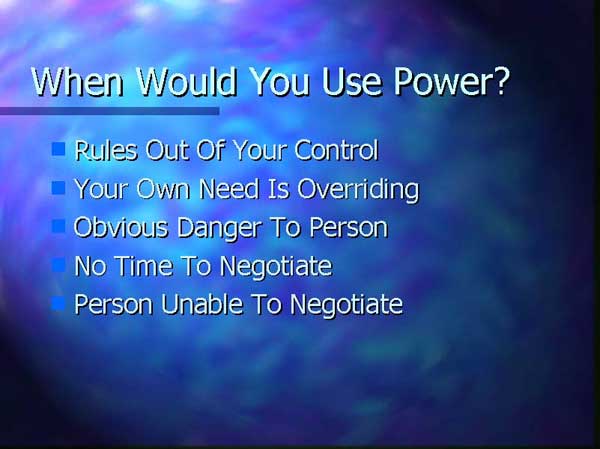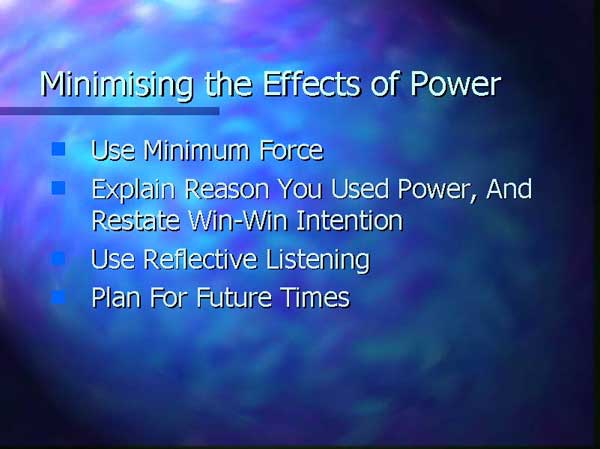WordPress database error: [Table 'adding_b51201.wp_SBConfiguration' doesn't exist]select * from wp_SBConfiguration where id='1'
Welcome to Module 8.1 Return to Dashboard
Module 8.2
Module 8.3

In the real world there are some situations where you will try and control another person’s behaviour by using power. Thomas Gordon suggests that these situations could include:
- Situations where you don’t have the say over what the rule is. If you work for a company you won’t be able to negotiate solutions that give away their property. If you are a teacher you won’t be able to arrange for someone to break a school rule. (You can, of course, work to change such rules.)
- Situations where your own need is overriding. You don’t, for instance, have to put up with a child repeatedly hitting you; forcibly preventing them may well be worth their response of frustration or resentment. You don’t have to put up with an employee repeatedly stealing your goods. Unilaterally restricting their after hours entry may be worth their resentment.
- Situations where it seems to you that another person is obviously in danger. It wouldn’t make sense to calmly watch someone walk in front of a speeding car, while sending the clear I message “Im really worried that that car will hit you!” Mostly their initial annoyance, at being grabbed and pulled off the road, will be worth coping with.
- Situations where there is no time to discuss the matter. If you have a conflict arise ten minutes before your plane is due to take off, you may decide it’s worth temporarily refusing to sort it out.
- Situations where talking with the person is impossible. This will include many conflicts involving children less than two years old, and conflicts with people who are drunk or fully unconnected to reality.

Minimising the Effects:
Even in these cases, it’s worth remembering the damage power causes. You can reduce the damage to your relationship by:
- Only using the minimum force to solve your problem. A child who is hitting you may need to be held, or even confined to a space away from you, until they can agree not to hit you; but they don’t need to be hit themselves (which is much the same behaviour you’re trying to stop), yelled insults at, shut in their room for the afternoon, and so on. An employee who is repeatedly stealing large amounts of stock may need to be fired or moved to an arrangement where such activity becomes impossible, but as Ricardo Semler points out, you don’t need to respond by docking their team’s pay and having all your employees semi-strip searched as they leave the plant each day. Doing these extra things is increasing their resentment and making more work for yourself.
- Explaining, afterwards, how you came to use power, and assuring the other person that this is not your usual intention.
- Using reflective listening to acknowledge their resentment, and spending time rebuilding your relationship.
- Planning how to avoid that situation in future.
These last three steps could be done quite simply, as in this example: “I’d like to talk about what happened before. I don’t mean to push you around, and only did that because I couldn’t find a way to safely sort it out at the time. I guess you felt pretty annoyed, and I’d like to try and sort out some agreement, so we don’t get into that situation again.”
Some Keys To Facilitating Conflict Resolution:
- Begin with open questions (eg “What has been the problem?”) and reflective listening both people at once (eg “So you’re both pretty upset about this situation.”). Check that you have an agreement to begin finding a win-win solution (a partnership). You may use the partnership preframes:
• Establish partnership “I believe you are in this together, and need each other to work it out”
• Refer to the whole relationship “This is only one aspect of your relationship.”
• Affirm possibilities “I’m sure together we can generate many options for solving this in a way that works for both of you.”
• Accept disagreement “Disagreeing doesn’t mean we can’t remember things we agree on.”
• Acknowledge specific difficulties “I know in the past you’ve had trouble due to a tendency to…. This time lets experiment by…” - Continue to restate both people’s needs and check for a full definition of
needs (eg “So you want… because… AND you want… because__”). Once
you have this, invite brainstorming of solutions (eg “So what ways could we get… AND…?”) - Acknowledge all solutions and hold off evaluating until you have at least three choices. Do not buy into being the “police” for the solutions. It is their problem, not yours. If you need to state your concern at any time, use an I message. Restate any critical comments by them into the I message format. Eg Conflict participant: “He’s been completely uncooperative through this conversation.” Faciltator: “So you’ve felt really frustrated at some of the comments he’s made.”
If you want to practice even more, here are some more bonus roleplays where you assist others in conflict resolution.